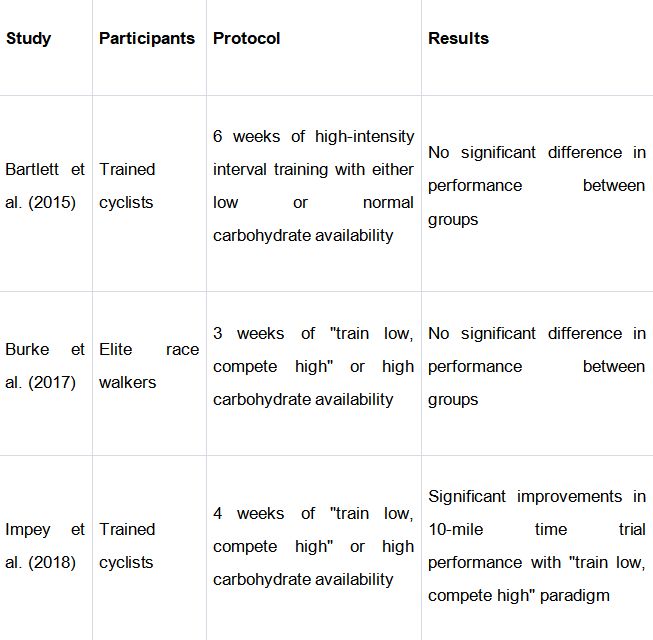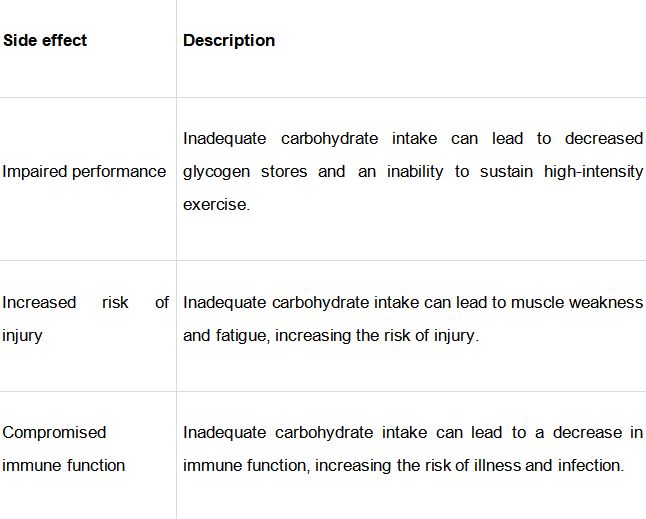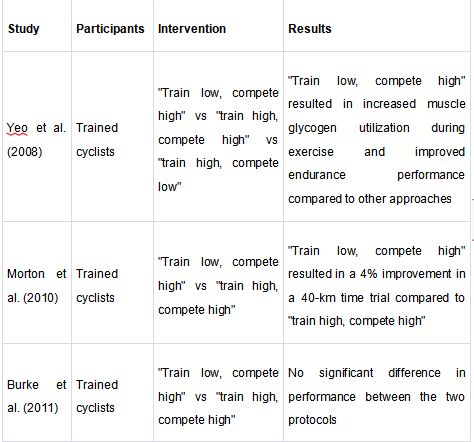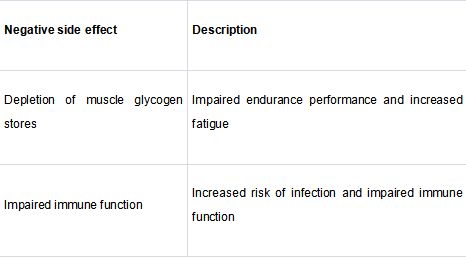Carbohydrate intake and Train low, compete high in Endurance Athletes Report
- Country :
Australia
Introduction
Cycling and other endurance sports need riders to be exceptionally physically fit and robust in order to perform at their highest levels. Due to the length and level of difficulty of the workouts they do, athletes constantly search for novel ways to enhance their performance. A particular approach that has gained popularity recently is the "train low, compete high" paradigm, which entails exercising when one has an inadequate supply of carbs and competing when there is a high availability of carbohydrates.
The rationale behind this tactic is that while participating in a scenario with abundant dietary fibre affordability may improve achievement, utilising in a setting with scarce glucose availability may improve adaptations to endurance training, such as increased fat metabolic processes and improved mitochondrial function. The basic workings of this paradigm is based on the concept of physiological flexibility, which refers to the body's ability to alternately utilise fats and carbohydrates as fuel during exercise.
However, there is conflicting information about the effectiveness of this approach, and coaches and sports scientists continue to disagree over the best training regimen for situations where there are few carbohydrate options available. Additionally, consuming insufficient amounts of carbohydrates might have unfavourable impacts including decreased performance, an increased chance of injury, and weakened immunity.
With a focus on female state-level cyclists aged 2027 who will be heading abroad to race in the European cycling season, we intend to explore the evidence supporting the effectiveness of the "train low, compete high" paradigm for endurance athletes in this literature review. We'll go through the possible drawbacks of insufficient carbohydrate intake as well as offer advice on how to apply this strategyor one that would be more suited for this set of athletesas well as suggestions for other approaches. We want to offer useful insights for coaches and players looking to improve their endurance performance by examining the most recent research on carbohydrate consumption and the "train low, compete high" concept.
Mechanisms and Rationale for "Train Low, Compete High" Paradigm
The idea of metabolic flexibility, or the body's capacity to alternate between utilising carbs and fats as fuel during exercise, is the foundation of the "train low, compete high" philosophy. The foundation of this idea is the knowledge that the body's choice of fuel during exercise is not fixed, but is instead impacted by elements including exercise intensity, duration, and nutritional condition.
Throughout low-intensity exercise, the body predominantly burns fat for gasoline, but during vigorous exercise, the body mostly burns carbohydrates for fuel. On the other hand, long-distance endurance athletes routinely engage in high-intensity activity, which can exhaust them and deplete their glycogen reserves. The "train low, compete high" paradigm therefore proposes that training with low carbohydrate availability might lead to adaptations to training for endurance, such as increased fat energy expenditure and upgraded mitochondrial structure, whereas competing with high glucose availability may improve accomplishment during competition.
The idea of depletion of glycogen, which explains a reduction in the total amount of carbohydrates that have been stored as glycogen in the muscles and liver, serves as the foundation for this paradigm. When glycogen supplies are depleted, the body switches to using lipids as fuel, which may improve fat metabolism and decrease the requirement for carbs during exertion. This shift in fuel choice may lead to greater sensitivity to insulin and other health-related metabolic parameters as well as improved endurance abilities.
The "train low, compete high" paradigm's effectiveness with endurance athletes has been the subject of several studies. Some of the most important results from these investigations are outlined in Table 1. Overall, the findings are inconsistent, with some studies claiming notable gains in performance with the "train low, compete high" paradigm and others documenting little to no change or even a decline in performance.
Table 1 provides an overview of research looking at the effectiveness of the "train low, compete high" mantra among endurance athletes.  It is obvious that enough carbohydrate intake is essential for the best endurance performance, despite the conflicting findings about the effectiveness of the "train low, compete high" paradigm. Poor performance, an increased risk of injury, and weakened immunity are among adverse consequences of insufficient carbohydrate consumption. Table 2 lists some of the main adverse consequences of insufficient carbohydrate consumption.
It is obvious that enough carbohydrate intake is essential for the best endurance performance, despite the conflicting findings about the effectiveness of the "train low, compete high" paradigm. Poor performance, an increased risk of injury, and weakened immunity are among adverse consequences of insufficient carbohydrate consumption. Table 2 lists some of the main adverse consequences of insufficient carbohydrate consumption.
Table 2 lists the negative consequences of consuming insufficient carbohydrates.

In order to improve their performance, endurance athletes frequently employ the "train low, compete high" approach. Although the data for its effectiveness is conflicting, it is obvious that an appropriate carbohydrate diet is essential for the best endurance performance. The possible drawbacks of insufficient carbohydrate intake should be carefully considered by coaches and athletes as they develop a plan that balances the advantages of the "train low, compete high" philosophy.
Evidence on the Efficacy of "Train Low, Compete High" Strategy
The evidence on the efficacy of the "train low, win high" strategy is contradictory, with certain research studies suggesting an outcome gain and others suggesting no discernible benefits. According to a study by Yeo et al. (2008), a "train low, competed high" strategy improved endurance performance and increased glycogen storehouse utilisation during exercise compared to a "train high, compete high" or "train high, compete low" methodology. The "train low, compete high" group of study participants completed a 40-km speed competition a lot faster than the group who observed the other protocols.
Morton et al. (2010) conducted another investigation and found that, contrasted to a "train high, compete high" approach, a "train low, compete high" strategy improved performance in endurance events. In the present research, cyclists who followed the "train low, compete high" moto performed better in a 40-kilometer speed event than those who followed the "train high, compete high" moto.
Previous research investigations have not demonstrated a substantial performance advantage for the "train low, compete high" method. A 10-km time trial was completed by skilled cyclists in a study by Burke et al. (2011) using either a "train low, compete high" or "train high, compete high" regimen. There were no discernible performance variations between the two regimens, compared to the researchers.
In a similar vein, Marquet et al. (2016) found no evidence of a performance difference between a group of well-trained cyclists using a "train low, compete high" method and a "train high, compete high" approach. The researchers came to the conclusion that not all athletes would benefit equally from the "train low, compete high" maxim, and that different people may react differently to it.
Overall, there is conflicting data about the effectiveness of the "train low, compete high" philosophy. While some research has concluded that this strategy significantly improves endurance performance, other studies have revealed no appreciable performance changes when compared to other procedures.
The results of numerous significant research on the effectiveness of the "train low, compete high" strategy in endurance athletes are compiled in Table1.
Table 1 summarises significant research on the effectiveness of the "train low, compete high" philosophy in endurance athletes.


Negative Side Effects Associated with Inadequate Carbohydrate Intakes
Although the "train low, compete high" philosophy may help endurance athletes perform better, it's crucial to take into account any potential drawbacks of consuming insufficient carbohydrates. Since carbohydrates are the main fuel for endurance activity, insufficient consumption can have a severe impact on one's health as well as performance. We will examine the facts in this part about the adverse consequences of endurance athletes consuming insufficient amounts of carbohydrates.
Muscle glycogen reserves being depleted is one of the most well-known adverse side effects of low-carbohydrate diet. High-intensity exercise is primarily fuelled by muscle glycogen, and when glycogen reserves are depleted, this can lead to tiredness and poor exercise performance. Burke et al.'s study from 2000 indicated that a low-carb diet had a substantial negative impact on muscle glycogen reserves and decreased endurance. Similar results were discovered in a different study by Lambert et al. (2001), which showed that trained endurance athletes' performance was hampered and their level of weariness rose.
Immune system dysfunction can also come from insufficient carbohydrate consumption. Low carbohydrate consumption can decrease immune function and raise the risk of infection. Carbohydrate is essential for the health of immunological cells. A low-carbohydrate diet was linked to immune system impairment and increased susceptibility to upper respiratory tract infections in endurance athletes, according to a research by Nieman et al.
Furthermore, insufficient carbohydrate consumption might worsen muscle repair and accelerate muscle breakdown. Glycogen synthesis and the avoidance of muscle breakdown require carbohydrates. According to a research by Tarnopolsky et al. (1992), endurance athletes who follow a low-carb diet have greater muscle breakdown and slowed muscle repair.
The adverse consequences of poor carbohydrate intakes in endurance athletes are collected in Table 1.Table 1 lists the negative consequences of low carbohydrate consumption in endurance athletes.


As a whole, low carbohydrate consumption can have unfavorable impacts including decreased immunity, depleted muscle glycogen reserves, and accelerated muscle breakdown. In order to promote their best performance and health, endurance athletes must guarantee enough carbohydrate intake. Even while the "train low, compete high" approach may be successful in enhancing endurance performance, it's crucial to carefully weigh the hazards vs the rewards.
Recommendations for "Train Low, Compete High" Strategy for State-level Female Cyclists
According to the evidence at hand, state-level female cyclists may find success with the "train low, compete high" paradigm as a good tactic for improving their endurance capabilities in competition. A skilled coach or sports nutritionist should be consulted before using this strategy, it is crucial to mention.
The riders might complete a portion of their training sessions with limited carbohydrate availability to put the "train low, compete high" concept into practice.Two tactics that might be utilised to achieve this include cutting back on carbohydrate intake before exercising or exercising while fasting. Keep in mind that low-carb training should only be carried out after careful preparation and should not be done during high-intensity training sessions as this might hurt performance and increase the risk of injury.
The riders should eat carbs before, during, and after exercise to ensure enough carbohydrate intake for best performance and recuperation. Based on their training objectives, body composition, and performance objectives, every athlete should have a different carbohydrate intake schedule and quantity. Additionally, it's critical to consume a variety of carbohydrate sources, such as fruits, vegetables, and grains, to guarantee proper intake of vitamins, minerals, and other nutrients.

